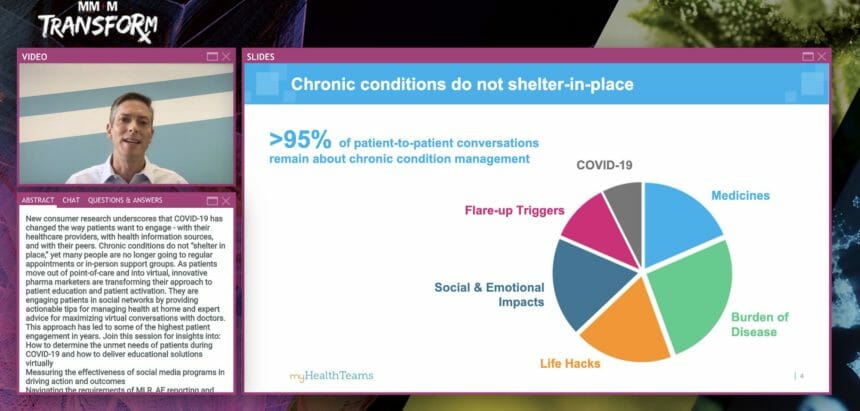The pandemic environment has compelled patients with chronic conditions to shift from in-person to virtual contact in order to engage with their vital support networks. But even as their care models have shifted, many of those patients have managed to continue treatment in a manner that’s meaningful, convenient and – most importantly – safe.
That was among the major takeaways from “Rewriting the Rules: How COVID-19 Has Changed Patient Engagement in Social,” presented during the first day of MM+M Transform by MyHealthTeams CEO and co-founder Eric Peacock. During the presentation, he shared five examples from the recent work and experience of his company, whose social networks serve 2.5 million members spread across 37 chronic conditions.
Early in the crisis, MyHealthTeams developed an educational resource center to educate endometriosis patients about telehealth and what they need to know in order to receive effective telemedicine care. As part of this push, the company partnered with AbbVie and Dr. Georgine Lamvuon on a video interview which addressed concerns about COVID-19, virtual endometriosis treatment and shelter-in-place pain management.
“She guided us through the types of things you definitely want to bring up with your doctor over telehealth and how that differs from in-person visits,” Peacock said.
Around the same time, MyHealth Teams collaborated with Dr. Hillary Norton and UCB on a video series explaining how spondyloarthritis patients can get access to world-class doctors. The videos answered basic questions: What is a non-radiographic axSpa? How do you discuss it with your doctor?
“This was an all-disease-state education, informing people what this thing is so they can ensure they see the right kind of doctor – in this case, a rheumatologist,” Peacock explained. “We’re just addressing a pent-up demand that people had before COVID, which is, ‘I want to hear from THE expert. I may not have the expert near where I live, but I want to hear from THE expert nevertheless.’”
To help multiple sclerosis patients adhere to a disease-modifying therapy (DMT) – some 35-40% aren’t on a DMT at any given time – MyHealthTeams and EMD Serono created an educational resource center. Its materials stressed that MS sufferers benefit by adhering to a DMT, regardless of which DMT they employ.
“EMD Serono talked about the research that showed if you’re on any kind of DMT consistently, you would have much better outcomes,” Peacock said. He added that the program’s videos covered ways of receiving assistance in paying for a given drug, how to administer it and how to deal with any side effects.
Additionally, a live video Q&A with MS expert Dr. Aaron Boster reviewed MS treatment issues amid the pandemic. “He literally went through every single DMT out there,” Peacock noted.
As for COPD patients, who can experience frightening shortness of breath triggered by factors like lack of sleep, stress or exhaustion, improving at-home health outcomes is crucial. Using a social-listening insight gleaned from its COPD team members about the value of pulmonary rehab, MyHealth Teams engaged Home Rehab Network’s Alex Grichuhin to create short videos on pursed-lip breathing, breathing muscle exercises and walking-and-breathing techniques.
The response, Peacock reported, was overwhelming: 92% of those who watched the videos said they tried the techniques and 48% reported trying the exercises at least 10 times. “That means it’s becoming part of their regular habit and they’re seeing the benefits of it,” he added.
Finally, MHT’s vitiligo team and the Global Vitiligo Foundation teamed up to hold a live doctor event, during which patients and caregivers could question doctors about symptoms and treatment options. Some 600 people attended, twice what MHT had ever recorded for a live doctor event.








